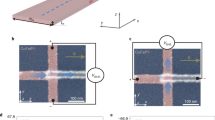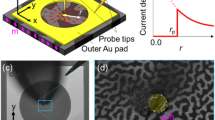Abstract
Magnetic field sensors are important in a variety of applications, including transport and medical devices. However, existing solid-state approaches for the detection of three-dimensional magnetic fields require multiple sensors, making the set-ups bulky. Here, we show that a single spin–orbit torque device composed of a Ta/CoFeB/MgO heterostructure can detect a vector magnetic field. In-plane and out-of-plane field components lead to the displacement of domain walls in the CoFeB layer, modulating the associated anomalous Hall effect resistance. Modulation of the anomalous Hall effect resistance varies linearly with the x, y and z components of a vector magnetic field. Our compact three-dimensional magnetic field sensor exhibits good linearity within a certain range (3.2%, 2.7% and 4.3% for the x, y and z directions, respectively) and high sensitivity (205, 282 and 1,845 V A−1 T−1 for the x, y and z directions, respectively). The sensor also exhibits low 1/f noise.
This is a preview of subscription content, access via your institution
Access options
Access Nature and 54 other Nature Portfolio journals
Get Nature+, our best-value online-access subscription
$29.99 / 30 days
cancel any time
Subscribe to this journal
Receive 12 digital issues and online access to articles
$119.00 per year
only $9.92 per issue
Buy this article
- Purchase on Springer Link
- Instant access to full article PDF
Prices may be subject to local taxes which are calculated during checkout




Similar content being viewed by others
Data availability
Source data are provided with this paper. Any additional data are available from the corresponding author upon reasonable request.
References
Michelena, M. D. Small magnetic sensors for space applications. Sensors (Basel) 9, 2271–2288 (2009).
Bird, J. & Arden, D. Indoor navigation with foot-mounted strapdown inertial navigation and magnetic sensors. IEEE Wirel. Commun. 18, 28–35 (2011).
Luo, Z. Y., Xu, Y. J., Yang, Y. M. & Wu, Y. H. Magnetic angular position sensor enabled by spin–orbit torque. Appl. Phys. Lett. 112, 262405 (2018).
Lee, J. R. et al. Experimental and theoretical investigation of the precise transduction mechanism in giant magnetoresistive biosensors. Sci. Rep. 6, 18692 (2016).
Reininger, T., Welker, F. & von Zeppelin, M. Sensors in position control applications for industrial automation. Sens. Actuat. A Phys. 129, 270–274 (2006).
Shibata, Y. et al. Imaging of current density distributions with a Nb weak-link scanning nano-SQUID microscope. Sci. Rep. 5, 15097 (2015).
Huber, M. E. et al. Gradiometric micro-SQUID susceptometer for scanning measurements of mesoscopic samples. Rev. Sci. Instrum. 79, 053704 (2008).
Ripka, P. New directions in fluxgate sensors. J. Magn. Magn. Mater. 215–216, 735–739 (2000).
Zheng, Y. H. et al. Sensitivity enhancement of graphene hall sensors modified by single-molecule magnets at room temperature. RSC Adv. 7, 1776–1781 (2017).
Labanowski, D. et al. Voltage-driven, local, and efficient excitation of nitrogen-vacancy centers in diamond. Sci. Adv. 4, eaat6574 (2018).
Wang, P. F. et al. High-resolution vector microwave magnetometry based on solid-state spins in diamond. Nat. Commun. 6, 6631 (2015).
Maze, J. R. et al. Nanoscale magnetic sensing with an individual electronic spin in diamond. Nature 455, 644–647 (2008).
Balasubramanian, G. et al. Nanoscale imaging magnetometry with diamond spins under ambient conditions. Nature 455, 648–651 (2008).
Taylor, J. M. et al. High-sensitivity diamond magnetometer with nanoscale resolution. Nat. Phys. 4, 810–816 (2008).
Zhao, N., Hu, J. L., Ho, S. W., Jones, T. K. W. & Liu, R. B. Atomic-scale magnetometry of distant nuclear spin clusters via nitrogen-vacancy spin in diamond. Nat. Nanotechnol. 6, 242–246 (2011).
Zieren V. A new silicon micro-transducer for the measurement of the magnitude and direction of a magnetic-field vector. Proc. International Electron Devices Meeting 669–672 (IEEE, 1980).
Hirsch, J. E. Spin Hall effect. Phys. Rev. Lett. 83, 1834–1837 (1999).
Nakayama, H. et al. Spin Hall magnetoresistance induced by a nonequilibrium proximity effect. Phys. Rev. Lett. 110, 206601 (2013).
Dietmayer, K. C. J. Magnetische Sensoren auf Basis des AMR-Effekts. Tech. Mess. 68, 269 (2009).
Yan, S. H. et al. Design and fabrication of full Wheatstone-bridge-based angular GMR. Sensors (Basel) 18, 1832 (2018).
Li, P. S. et al. Electric field manipulation of magnetization rotation and tunneling magnetoresistance of magnetic tunnel junctions at room temperature. Adv. Mater. 26, 4320–4325 (2014).
Yuasa, S., Nagahama, T., Fukushima, A., Suzuki, Y. & Ando, K. Giant room-temperature magnetoresistance in single-crystal Fe/MgO/Fe magnetic tunnel junctions. Nat. Mater. 3, 868–871 (2004).
Ohno, H., Stiles, M. D. & Dieny, B. Spintronics. Proc. IEEE 104, 1782–1786 (2016).
Kordic, S. Integrated 3-D magnetic sensor based on an n-p-n transistor. IEEE Electron Device Lett. 7, 196–198 (1986).
Popovic, R. S. The vertical Hall-effect device. IEEE Electron Device Lett. 5, 357–358 (1984).
Kordic, S. Sensitivity of the silicon high-resolution 3-dimensional magnetic-field vector sensor. Proc. International Electron Devices Meeting 188–191 (IEEE, 1986).
Wei, F. F. et al. Magnetic field sensor based on a combination of a microfiber coupler covered with magnetic fluid and a sagnac loop. Sci. Rep. 7, 4725 (2017).
Ettelt, D. et al. 3D magnetic field sensor concept for use in inertial measurement units (IMUs). J. Microelectromech. Syst. 23, 324–333 (2014).
Luong, V. S. et al. Planarization, fabrication and characterization of three-dimensional magnetic field sensors. IEEE Trans. Nanotechnol. 17, 11–25 (2017).
Chen, J., Wurz, M. C., Belski, A. & Rissing, L. Designs and characterizations of soft magnetic flux guides in a 3-D magnetic field sensor. IEEE Trans. Magn. 48, 1481–1484 (2012).
Mihai Miron, I. et al. Current-driven spin torque induced by the Rashba effect in a ferromagnetic metal layer. Nat. Mater. 9, 230–234 (2010).
Hoffmann, A. Spin Hall effects in metals. IEEE Trans. Magn. 49, 5172–5193 (2013).
Liu, L. Q., Lee, O. J., Gudmundsen, T. J., Ralph, D. C. & Buhrman, R. A. Current-induced switching of perpendicularly magnetized magnetic layers using spin torque from the spin Hall effect. Phys. Rev. Lett. 109, 096602 (2012).
Bhowmik, D. et al. Deterministic domain wall motion orthogonal to current flow due to spin orbit torque. Sci. Rep. 5, 11823 (2015).
Zhang, S. et al. Spin–orbit-torque-driven multilevel switching in Ta/CoFeB/MgO structures without initialization. Appl. Phys. Lett. 114, 042401 (2019).
Fan, W. J. et al. Asymmetric spin–orbit-torque-induced magnetization switching with a noncollinear in-plane assisting magnetic field. Phys. Rev. Appl. 11, 034018 (2019).
Endo, M., Kanai, S., Ikeda, S., Matsukura, F. & Ohno, H. Electric-field effects on thickness dependent magnetic anisotropy of sputtered MgO/Co40Fe40B20/Ta structures. Appl. Phys. Lett. 96, 212503 (2010).
Chang Lau, Y., Sheng, P., Mitani, S., Chiba, D. & Hayashi, M. Electric field modulation of the non-linear areal magnetic anisotropy energy. Appl. Phys. Lett. 110, 022405 (2017).
Hayashi, Y. et al. Electric-field effect on magnetic anisotropy in Pt/Co/Pd/MgO structures deposited on GaAs and Si substrates. Appl. Phys. Express 11, 013003 (2018).
Yamanouchi, M. et al. Domain structure in CoFeB thin films with perpendicular magnetic anisotropy. IEEE Magn. Lett. 2, 3000304 (2011).
Papusoi, C. et al. Probing fast heating in magnetic tunnel junction structures with exchange bias. New J. Phys. 10, 103006 (2008).
Prejbeanu, I. L. et al. Thermally assisted MRAMs: ultimate scalability and logic functionalities. J. Phys. D 46, 074002 (2013).
Song, M. et al. Low current writing perpendicular magnetic random access memory with high thermal stability. Mater. Des. 92, 1046–1051 (2016).
Wang, M. X. et al. Current-induced magnetization switching in atom-thick tungsten engineered perpendicular magnetic tunnel junctions with large tunnel magnetoresistance. Nat. Commun. 9, 671 (2018).
Pai, C. F. et al. Spin transfer torque devices utilizing the giant spin Hall effect of tungsten. Appl. Phys. Lett. 101, 122404 (2012).
Niimi, Y. et al. Giant spin Hall effect induced by skew scattering from bismuth impurities inside thin film CuBi alloys. Phys. Rev. Lett. 109, 156602 (2012).
Jeng, J. T., Chiang, C. Y., Chang, C. H. & Lu, C. C. Vector magnetometer with dual-bridge GMR sensors. IEEE Trans. Magn. 50, 1–4 (2014).
Lu, C. C. & Huang, J. A 3-axis miniature magnetic sensor based on a planar fluxgate magnetometer with an orthogonal fluxguide. Sensors (Basel) 15, 14727–14744 (2015).
Zhang, Y., Hao, Q. & Xiao, G. Low-frequency noise of magnetic sensors based on the anomalous Hall effect in Fe–Pt alloys. Sensors (Basel) 19, 3537 (2019).
Acknowledgements
This work was supported by the National Natural Science Foundation of China (NSFC grants 62074063, 61821003, 61904051, 61904060, 51671098 and 61674062), the National Key Research and Development Program of China (grant no. 2020AAA0109000), the Research Project of Wuhan Science and Technology Bureau (grant no. 2019010701011394) and the Fundamental Research Funds for the Central Universities (HUST: 2018KFYXKJC019). We acknowledge assistance from G. Wu and L. Zhan in providing the equipment for noise measurements.
Author information
Authors and Affiliations
Contributions
L.Y. conceived the ideas and designed the experiments. S.Z. fabricated the samples and implemented the experimental set-up. R.L. performed the experimental measurements and the simulations by OOMMF and COMSOL. R.L., S.Z., Z.G., J.O. and L.Y. analysed the results. Y.X. and L.X. provided the MOKE equipment and S.Z. performed the MOKE measurements. M.S., J.H., Q.Z. and X.Y. provided the theoretical support. R.L., S.Z., S.L., Z.G. and L.Y. wrote the manuscript. All authors discussed the data and contributed to the manuscript.
Corresponding author
Ethics declarations
Competing interests
The authors declare no competing interests.
Additional information
Peer review information Nature Electronics thanks Coriolan Tiusan and the other, anonymous, reviewer(s) for their contribution to the peer review of this work.
Publisher’s note Springer Nature remains neutral with regard to jurisdictional claims in published maps and institutional affiliations.
Supplementary information
Supplementary Information
Supplementary Sections 1–7, Figs. 1–12 and Table 1.
Source data
Source Data Fig. 2
Statistical source data.
Source Data Fig. 3
Statistical source data.
Source Data Fig. 4
Statistical source data.
Rights and permissions
About this article
Cite this article
Li, R., Zhang, S., Luo, S. et al. A spin–orbit torque device for sensing three-dimensional magnetic fields. Nat Electron 4, 179–184 (2021). https://doi.org/10.1038/s41928-021-00542-8
Received:
Accepted:
Published:
Issue Date:
DOI: https://doi.org/10.1038/s41928-021-00542-8
This article is cited by
-
Ferroelectric domain-wall logic units
Nature Communications (2022)
-
Three-dimensional sensing of the magnetic-field vector by a compact planar-type Hall device
Communications Materials (2021)



